
Hasegawa 1/72 Shinmeiwa US-1 "Rescue Ivory"
By Chris Banyai-Riepl
Overview
The Shin Meiwa PS-1 was an evolution of Kawanishi's wartime flying boat experience coupled with post-war evaluation of the Grumman HU-16 Albatross. The result was a four-engined turboprop STOL flying boat with an innovative boundary layer control system. Japan ordered 21 of these patrol aircraft, which were eventually replaced by P-3s by 1989.
Shortly after the PS-1 entered service, the JMSDF wanted a search & rescue variant of the type. By removing the military equipment, Shin Meiwa was able to increase the fuel capacity, as well as add true landing gear (the PS-1 had beaching gear only) and rescue equipment. The US-1 first flew in 1974, and remained in service for decades. An updated version was then developed in the late 1990s, with improved engines and aerodynamic changes, which entered service in 2007.
The Kit
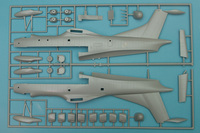 The Hasegawa kit of the PS-1/US-1 dates back many years, and it remains the only choice for those wanting a 1/72 model of this flying boat. As this is an older kit, it does feature raised panel lines and has a simplistic interior, but it is fairly accurate in outline. In addition to the medium gray plastic parts, this release includes some resin bits, including some corrected mainwheel fairings. The decal sheet is large and includes standard markings as well as generic stencils, walkways, and more.
The Hasegawa kit of the PS-1/US-1 dates back many years, and it remains the only choice for those wanting a 1/72 model of this flying boat. As this is an older kit, it does feature raised panel lines and has a simplistic interior, but it is fairly accurate in outline. In addition to the medium gray plastic parts, this release includes some resin bits, including some corrected mainwheel fairings. The decal sheet is large and includes standard markings as well as generic stencils, walkways, and more.
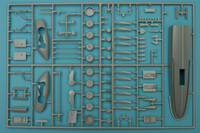 Jumping into construction, while this is a large model, it's also fairly simple overall. The cockpit, as noted, is basic, featuring a main floor, rear bulkhead, three seats, and a separate instrument panel. The control wheels are made up of separate wheels and sticks, and there are decals for the consoles and instrument panel. While there is undoubtedly room for lots of extra detail here, realistically not much will be seen once it is all together in the fuselage. Other fuselage interior bits include the nose wheel well, which fits into the lower forward hull.
Jumping into construction, while this is a large model, it's also fairly simple overall. The cockpit, as noted, is basic, featuring a main floor, rear bulkhead, three seats, and a separate instrument panel. The control wheels are made up of separate wheels and sticks, and there are decals for the consoles and instrument panel. While there is undoubtedly room for lots of extra detail here, realistically not much will be seen once it is all together in the fuselage. Other fuselage interior bits include the nose wheel well, which fits into the lower forward hull.
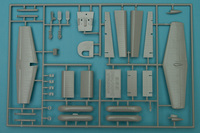 Moving to the wings, these have separate flaps, both inner and outer. These are both split into upper and lower pieces, inside of which are trapped the hinges so that you can display the flaps extended. These are then trapped between the wing halves, which have large tabs that mate up with the fuselage. This provides a very positive attachment point, and should ensure excellent alignment. The kit includes various parts for the PS-1 as well, such as the under-wing pods, so you'll have some interesting shapes for the spares box.
Moving to the wings, these have separate flaps, both inner and outer. These are both split into upper and lower pieces, inside of which are trapped the hinges so that you can display the flaps extended. These are then trapped between the wing halves, which have large tabs that mate up with the fuselage. This provides a very positive attachment point, and should ensure excellent alignment. The kit includes various parts for the PS-1 as well, such as the under-wing pods, so you'll have some interesting shapes for the spares box.
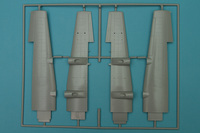 The engine nacelles are separate from the wings, and each one is made up from two side pieces, a separate front piece, and two small scoops. The instructions also include a diagram for the large fences that are found on the outboard side of the nacelles. The propellers are made up from a two-piece hub with separate blades. These completed nacelles then meet up with the rear section on the wings, and given the age of the molds, this might be an area that needs some extra help.
The engine nacelles are separate from the wings, and each one is made up from two side pieces, a separate front piece, and two small scoops. The instructions also include a diagram for the large fences that are found on the outboard side of the nacelles. The propellers are made up from a two-piece hub with separate blades. These completed nacelles then meet up with the rear section on the wings, and given the age of the molds, this might be an area that needs some extra help.
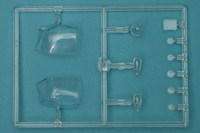 Putting the fuselage together is probably the most complex assembly, as it has a separate rudder, separate upper deck panel, separate lower hull panels, a completely separate lower forward hull, and a separate nose. All of these different assemblies will benefit from lots of test fitting, and in the case of the forward lower hull, perhaps the addition of some spacers to ensure a good fit. The canopy comes split into right and left halves, which adds to the challenges of building a filler-free model. With plenty of test fitting and some judicious use of added alignment strips, the need for filler should be minimized.
Putting the fuselage together is probably the most complex assembly, as it has a separate rudder, separate upper deck panel, separate lower hull panels, a completely separate lower forward hull, and a separate nose. All of these different assemblies will benefit from lots of test fitting, and in the case of the forward lower hull, perhaps the addition of some spacers to ensure a good fit. The canopy comes split into right and left halves, which adds to the challenges of building a filler-free model. With plenty of test fitting and some judicious use of added alignment strips, the need for filler should be minimized.
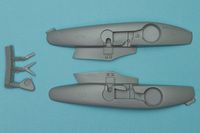 The resin main wheel bits look like they will fit nicely up against the fuselage, but there is a panel behind each one that might cause problems, so take care with fitting that piece. Other resin bits include a couple small antenna blades on the forward fuselage, and an exhaust vent on the vertical fin. The landing gear itself is simplistic, but to be fair, the real thing is a simple, sturdy design. With the addition of the horizontal stabilizer, this one is ready for painting.
The resin main wheel bits look like they will fit nicely up against the fuselage, but there is a panel behind each one that might cause problems, so take care with fitting that piece. Other resin bits include a couple small antenna blades on the forward fuselage, and an exhaust vent on the vertical fin. The landing gear itself is simplistic, but to be fair, the real thing is a simple, sturdy design. With the addition of the horizontal stabilizer, this one is ready for painting.
The color scheme found on the US-1 is an attractive one, with the lower hull and wings in aircraft gray, the upper fuselage in white, and an orange vertical fin, orange wingtips, orange nose, and orange tailplane tips. Further adding to the color, the rescue aircraft also featured a yellow band trimmed in black around the rear fuselage. With all those different colors, be ready for lots of masking, but the end result will be worth it.
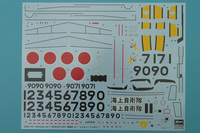 For the actual decals, there are two schemes covered in the instructions, but there are enough numbers to do any one of the 14 US-1 aircraft built. The first option is a US-1A from the 72st SQ, aircraft number 90. The second option is a US-1 of the Iwakuni Air Detachment, aircraft number 71. This aircraft also has an emblem on the tail. Aside from that, the markings are the same, and the decals even include the yellow/black fuselage band. Although provided as a decal, this is probably best painted. The decals are well printed and should go down well over the raised rivets.
For the actual decals, there are two schemes covered in the instructions, but there are enough numbers to do any one of the 14 US-1 aircraft built. The first option is a US-1A from the 72st SQ, aircraft number 90. The second option is a US-1 of the Iwakuni Air Detachment, aircraft number 71. This aircraft also has an emblem on the tail. Aside from that, the markings are the same, and the decals even include the yellow/black fuselage band. Although provided as a decal, this is probably best painted. The decals are well printed and should go down well over the raised rivets.
Conclusion
This is a welcome re-release of the classic Hasegawa US-1 that is all the better due to the inclusion of the resin upgrades for the main wheel wells. If you have a desire to build a US-1, this is the one to pick up. My thanks to Hasegawa USA for the review sample.
